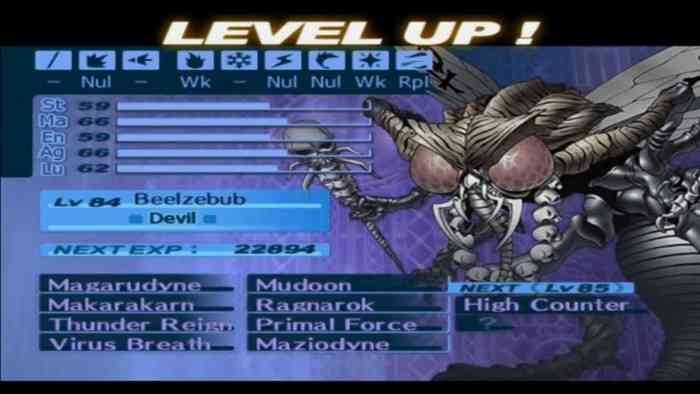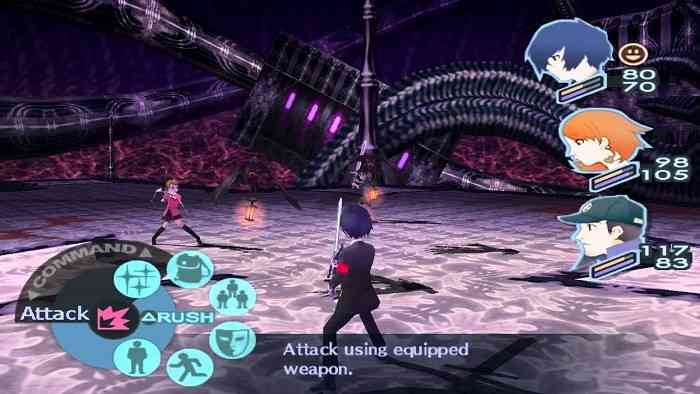After some battles, a card game appears where the player sees cards with different prizes, such as weapons, money, healing, increased experience, or Persona. The player has to follow the flipped over, shuffled cards, in an attempt to choose their most desired prize. Sometimes cards will have a skull over them, and if chosen, they will summon death, which will go after them player like a white ghost in Bubble Bobble, until they advance to the tower’s next level. Death will surely kill you if you attempt to fight it, and it’s not until the late game, when the player feels like they might have a chance of winning (more on this later). If the Persona is not one the player has, they will gain it, and it will be added to the database of summonable Personas. The player can only have a few Personas equipped at any given time, so sometimes Persona gain adds to the stress of wanting to get to those check points.
Although it seems like Tarot card shuffling is the way to gain Personas at first, the player will eventually find that fusing them will yield greater results. Each Persona is one of 20 or so types, and as the player’s affinity with that type levels up (see Japanese school-life gameplay section), the Persona will gain more experience right off the bat. The player gains access to more powerful Personas as they level up, so they rarely have a chance to get comfortable with a party. Because of this, most of the levelling up Personas do is not from combat, but from affinity increase. You can save your Persona before fusing, and can purchase them back after using them to create something else. One of the most enjoyable parts of playing through Persona 3 was planning which Personas I was going to fuse next. And once you get to the late game, they become incredibly powerful and provide the player with godly power.

Some techniques get passed on when fusing Personas, and a lot of the fusing the player does isn’t to get new Personas, so much as to create Personas with the best abilities. For example, I didn’t use the Alice Persona for very long, but she had the most powerful dark attack in the game, so I kept fusing that ability into other Personas. Or sometimes I would create Personas with lots of resistances, so I could switch to them when faced with powerful boss attacks. At the beginning of the game, Personas can only be fused by turning two or three Personas into one new one, but later on, the player can create powerful Personas through turning four, five, or six Personas into one. And which abilities your new Persona will get, from the Personas you’re creating it with, are random, but it’s fun to keep mixing Personas to see which abilities they will gain on top of their core set. Don’t like the ability combo, exit out of that fusion menu, and try again with the same Personas to get a new ability list. This might sound tedious, but it yielded a strange amount of satisfaction, once I got that perfect combo of abilities. It also allows the player to test out abilities they might otherwise not use, which adds a deceptive amount of variety in terms of combat options.
The school sim portion of the game actually is a really clever levelling/ customization system. The game’s timeline lasts almost an entire year, and every day the player goes to class, does something after school, then heads back to the dorm and does something at night. Sometimes there are story events like class trips, summer vacation, etc. but for the most part the player has control over their day. At the end of each month, the team battles another powerful shadow that manifests, so the player must make sure they gain enough experience that they can defeat the boss, get far enough in Tartarus to advance to the next area after defeating the boss, and perform well in school/ balance their relationships with their classmates.

One would expect that solving the mystery of The Dark Hour would take precedence over eating noodleswith your friends after school, but almost everything the player does during the day, affects one stat or another. Those 20 Persona types are each associated with a different person in your neighborhood, which you can develop a relationship with. For example, befriend the star athlete from your rival school, and you can build up your affinity with the Star Persona-type; successfully date the treasurer for your student council, and you can build up your affinity with the Judgement Persona-type. Although it is possible to max out all the Persona affinities in one playthrough, it requires the player to make every moment count, and likely won’t be done successfully until a New Game + playthrough. Each Persona-type has an ultimate Persona, and they range from staring levels of 50-ish to 90-ish, so it pays off to max out the early relationships as they come. Some of the best spells in the game are gain from earlier final Personas. SPOILER: For example, the final Magician Persona is Surt, which can be fused when Makoto is at level 52. Although there are other Persona, which start on much higher levels, Surt’s final ability is Ragnarok, which is the best Fire spell in the game, and should be gained as early as possible, to fuse with a higher level Fire Persona, or to give to a Persona that the player is building to use multiple elements. END SPOILERS.
Other options you have after school are to go to the arcade, which has games that increase your player or Persona stats, to buy weapons, armor, and items, to complete quests which are given by the mysterious beings that allow the player to fuse Personas, or lots of other weird options. One of my only major complaints about Persona 3 FES is that when purchasing equipment, the player can only see what Makoto has equipped. You’ll have to commit all the other characters’ gear to memory, which is just obnoxious. This would’ve been archaic even in a Super Nintendo RPG.
Character’s also get tired from exploring Tartarus, and can’t be used unless they’re in good condition, so players need to take nights off and get rested to place themselves in better condition, in order to tackle the labyrinth at maximum strength.

Persona 3 FES’ late game is where it really shines. Trying to build up all the Persona affinities and experimenting with fusing the late-game ultimate abilities, is an RPG fan’s dream come true! I felt pretty god-like by the time I decided I was ready to take on the final boss. Eventually I felt powerful enough that I wanted to see if I could beat Death. I eventually did, and it unlocked a final dungeon that made it so levelling up my characters and ultimate Personas was never a grind-fest. SPOILERS: There is also a very important story choice the player will have to make near the end of the game. Depending on the choice the player makes, it adds another 20 or so hours of game play to what was already a 70 hour or so game. This choice really blew me away, and it was such a big deal that I reset my game, and made two save files, so I could see both outcomes. This choice reminded me of the decision to fight or not fight Magus at the end of Chrono Trigger. END SPOILERS. All this late game content is what takes a 9.5 with some flaws, and makes it a 10: a truly transcendent classic.
The graphics is Persona 3 FES have a very stylized anime look. The characters and environments are among the most gorgeous on the PS2. The menus have a slick, graffiti style and are still arguably the best looking I have ever seen. And the anime cutscenes are gorgeous, bringing me back to my PS1 days where every video was a real treat.
The monster design in this game is truly incredible. In the beginning they might seem a little underwhelming, but the all of a sudden you realize that you are controlling a cute snowman, and a bondage wrapped angel at the same time. Their depictions of Satan, Thor, Beelzebub, Quezacoatl, Asura, etc. are all interesting. And for the really deviant folks out there, you will get a late-game penis demon riding a chariot. That’s right. Fuse Mara. You’ll see…
The game’s soundtrack is as fantastic as the graphics. Every track is a catchy hip hop, electronic, or rock song. The soundtrack is good enough that I downloaded and listened to it after I beat the game, which is not something I often do, but I found myself singing some of these songs long after the game was over. “Iwatodai Station” is a great example of how bizarre and catchy the music in this game is:
Whenever I showed the game to people I would end up singing the scat portion of this song at them while it played in-game. It’s unavoidable. Other standout tracks include: “Burn My Dread”, “Want To Be Close”, “When The Moon’s Reaching For The Stars”, and “This Mysterious Feeling” (the song that plays whenever you’re talking to someone sleazy). Over time, the music changes in areas the player regularly visits, and eventually the player is given the ability to choose their dungeon music!
So what’s the difference between regular Persona 3, and FES? FES has lots of minor additions including: secret videos about dorm mates, walks Koromaru can be taken out on, tweaks to timing of Social Links, additions to Naganaki Shrine, and new Quests, character equipment, minor story events, and a Hard Mode were added. The best reason to get Persona 3 FES is that some new Personas were added. SPOILERS: For example, one of the most powerful Personas in the game is Lucifer, who looks like an angel. In FES, Lucifer was renamed as Helel, and the new Lucifer Persona has a demon form and is one of the most powerful in the game. END SPOILERS. Changes like this make the late game much more epic and interesting.
The most advertised feature of FES is a second game called The Answer (the main Persona 3 game being called The Journey). It’s a 30 hour long bonus story, which takes place after the events of Persona 3, and is from the point of view of Aigis, who gains Makoto’s multi-Persona using abilities. There are no Social Links, but a lot of dungeon crawling, and a new character. I recommend not playing it right after The Journey, as you’ll be starting from level 1, but after a few months, it provides a great denouement to the main game. Aside from the fancy packaging that Persona 3 comes in, there is no reason to get it over FES.
Whenever these articles are released on COGconnected, they will be split up into 4 weekly parts: The Intro, The History, The Review, and The Verdict. So here ends The Review. Tune in next week for The Verdict!